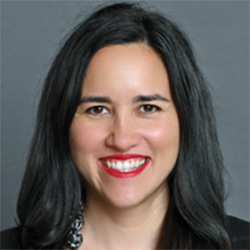When Your Patient Needs an Ophthalmologist: A Q&A with Ophthalmologist Dr. Michelle Cabrera
Seattle Children’s Ophthalmology receives thousands of referrals each year and many of these patients can be managed by other community providers. We sat down with Dr. Michelle Cabrera to discuss the difference between Ophthalmology and Optometry and what kinds of patients can be successfully treated by both.
Q: Can you explain the difference between Ophthalmology and Optometry when it comes to pediatric patients?
 Michelle Trager Cabrera, MD: Ophthalmologists went to medical school and are MDs and surgeons. Seattle Children’s optometrists went to optometry school and are ODs. Our optometrists have also undergone an additional year of Optometry residency to become experts in managing pediatric patients. While optometrists are experts on the eyes, glasses, contact lenses, and low vision, ophthalmologists are better equipped to manage eye disease that require medications, imaging, surgery, or multidisciplinary management with other medical specialties. Optometrists are able to manage simpler eye diseases in children, such as amblyopia that can be managed with glasses and patching alone. Optometrists are also a great option for screening eye examinations and tend to have better availability than ophthalmologists, so they may get the patient in quickly for triage and, if appropriate, can refer the patient to ophthalmology.
Michelle Trager Cabrera, MD: Ophthalmologists went to medical school and are MDs and surgeons. Seattle Children’s optometrists went to optometry school and are ODs. Our optometrists have also undergone an additional year of Optometry residency to become experts in managing pediatric patients. While optometrists are experts on the eyes, glasses, contact lenses, and low vision, ophthalmologists are better equipped to manage eye disease that require medications, imaging, surgery, or multidisciplinary management with other medical specialties. Optometrists are able to manage simpler eye diseases in children, such as amblyopia that can be managed with glasses and patching alone. Optometrists are also a great option for screening eye examinations and tend to have better availability than ophthalmologists, so they may get the patient in quickly for triage and, if appropriate, can refer the patient to ophthalmology.
Q: We know that access is challenging – can you share what conditions definitely need to be seen by an Ophthalmologist at Seattle Children’s?
Dr. Cabrera: As mentioned above, optometrists are well equipped to manage many pediatric conditions, but there are some things that require Ophthalmologic care: Optic nerve disease, strabismus, active retinopathy of prematurity (in infancy), trauma, retinal disease, active glaucoma, cortical visual impairment, cataracts, lens dislocation, known uveitis, corneal opacity, leukocoria, chronic red eye lasting longer than one month, nasolacrimal duct obstruction that may need surgery, and other surgical consultation. We also work closely with our colleagues to help manage retinoblastoma or other tumors. Additionally, we often see second opinions or referrals for management from other pediatric ophthalmologists and optometrists.
Q: For patients who do not meet referral criteria, what alternatives do primary care providers have to make sure their patient’s needs are addressed?
Dr. Cabrera: There are wonderful pediatric eye care providers in the community. Please see the list of recommended providers on our website. If there are any questions or concerns, particularly if the patient is having trouble obtaining access elsewhere, please feel free to reach out to us.
Q: What would you consider an Ophthalmologic emergency and advise patients to go to the ED for?
Dr. Cabrera: There are some scenarios that are rather serious and would be best treated as soon as possible in the ED. Some examples would be trauma to the eye resulting in vision loss or a potential ruptured globe. Additionally, if a patient has new vision loss or eye misalignment accompanied by other neurologic symptoms, such as numbness, weakness or severe headaches, or accompanied by flashes and floaters we would want to see them in the ED.
Resources
- Ophthalmology Refer a Patient page, with many additional resources listed toward the bottom of the page
- Recommended Community Providers